Stakeholder Analysis and Strategy Development Report: Snap Inc.
VerifiedAdded on 2020/04/07
|17
|2916
|45
Report
AI Summary
This report presents a stakeholder analysis of Snap Inc., applying the stakeholder view model to categorize various stakeholder groups. It identifies supportive, non-supportive, mixed blessing, and marginal stakeholders, detailing their roles and influence on the company. The report further recommends specific strategic programs for each stakeholder category, including involvement, defensive, swing, and hold strategies. These recommendations aim to enhance stakeholder management, address relevant issues, and ultimately contribute to Snap Inc.'s success. The analysis covers aspects such as revenue recognition, investor relations, government regulations, and competitive landscape, offering insights into the challenges and opportunities associated with each stakeholder group. The conclusion summarizes the findings and emphasizes the importance of proactive stakeholder management for sustainable organizational performance. This report provides valuable insights into stakeholder relationships and strategic planning for Snap Inc.
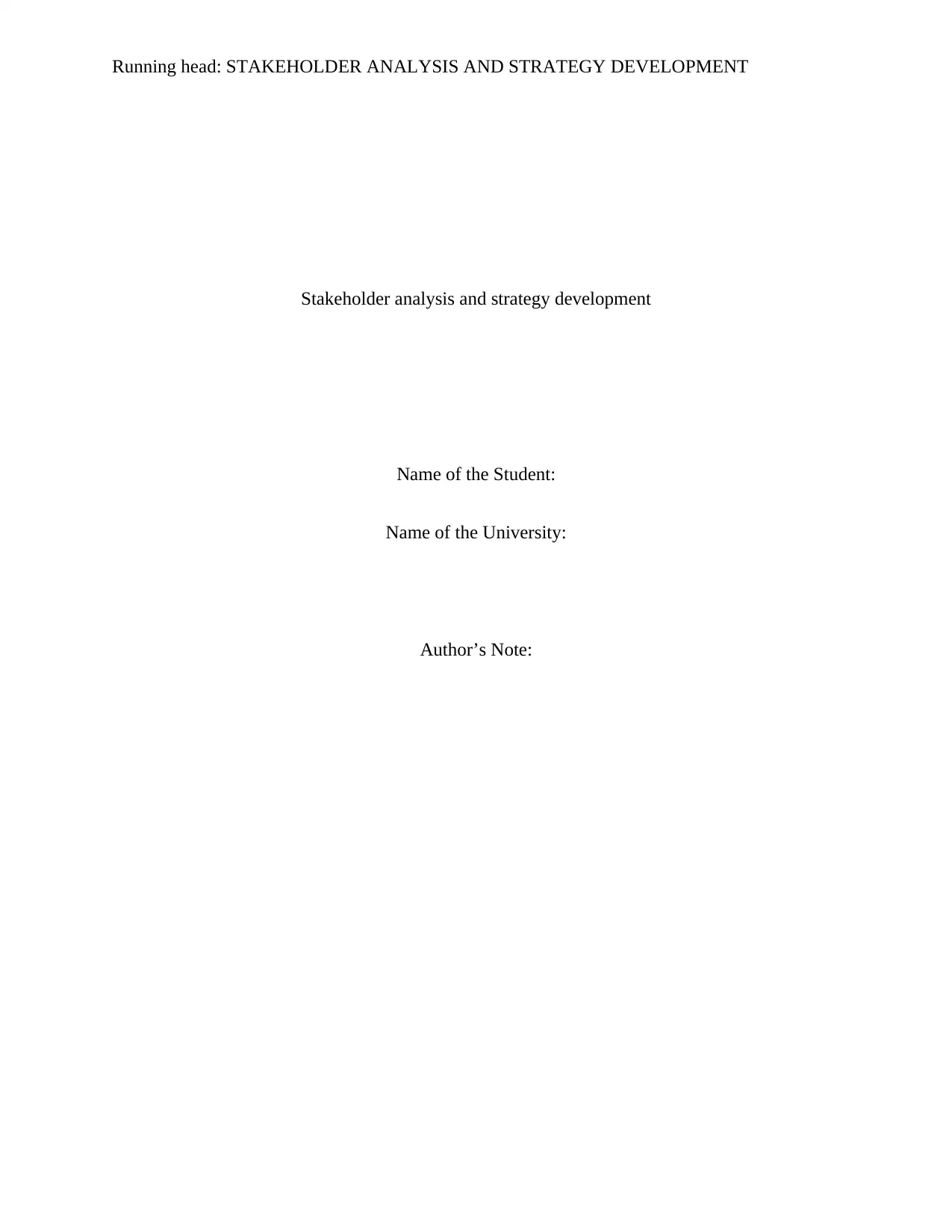
Running head: STAKEHOLDER ANALYSIS AND STRATEGY DEVELOPMENT
Stakeholder analysis and strategy development
Name of the Student:
Name of the University:
Author’s Note:
Stakeholder analysis and strategy development
Name of the Student:
Name of the University:
Author’s Note:
Paraphrase This Document
Need a fresh take? Get an instant paraphrase of this document with our AI Paraphraser

1STAKEHOLDER ANALYSIS AND STRATEGY DEVELOPMENT
Executive summary:
The report is prepared for demonstrating the application of stakeholder view model for analyzing
the different categories of stakeholders of Snap Inc. A diagram depicting different groups of
stakeholders has been presented with Snap Inc as central organization that is surrounded by wide
range of stakeholders. In addition to this, generic strategic programs have been recommended for
each stakeholder’s category. Later part of report deals with the recommendation of strategic
programs for stakeholders and helps in addressing the relevant issues associated with them.
Executive summary:
The report is prepared for demonstrating the application of stakeholder view model for analyzing
the different categories of stakeholders of Snap Inc. A diagram depicting different groups of
stakeholders has been presented with Snap Inc as central organization that is surrounded by wide
range of stakeholders. In addition to this, generic strategic programs have been recommended for
each stakeholder’s category. Later part of report deals with the recommendation of strategic
programs for stakeholders and helps in addressing the relevant issues associated with them.

2STAKEHOLDER ANALYSIS AND STRATEGY DEVELOPMENT
Table of Contents
Introduction:....................................................................................................................................3
Discussion:.......................................................................................................................................3
Identification of stakeholders of Snapchat:.....................................................................................3
Analysis of stakeholder using stakeholder view model:..................................................................5
Categorization of stakeholders and generic strategic program for selected stakeholders:..............7
Recommended strategic program:.................................................................................................10
Conclusion:....................................................................................................................................12
References list:...............................................................................................................................13
Table of Contents
Introduction:....................................................................................................................................3
Discussion:.......................................................................................................................................3
Identification of stakeholders of Snapchat:.....................................................................................3
Analysis of stakeholder using stakeholder view model:..................................................................5
Categorization of stakeholders and generic strategic program for selected stakeholders:..............7
Recommended strategic program:.................................................................................................10
Conclusion:....................................................................................................................................12
References list:...............................................................................................................................13
⊘ This is a preview!⊘
Do you want full access?
Subscribe today to unlock all pages.

Trusted by 1+ million students worldwide
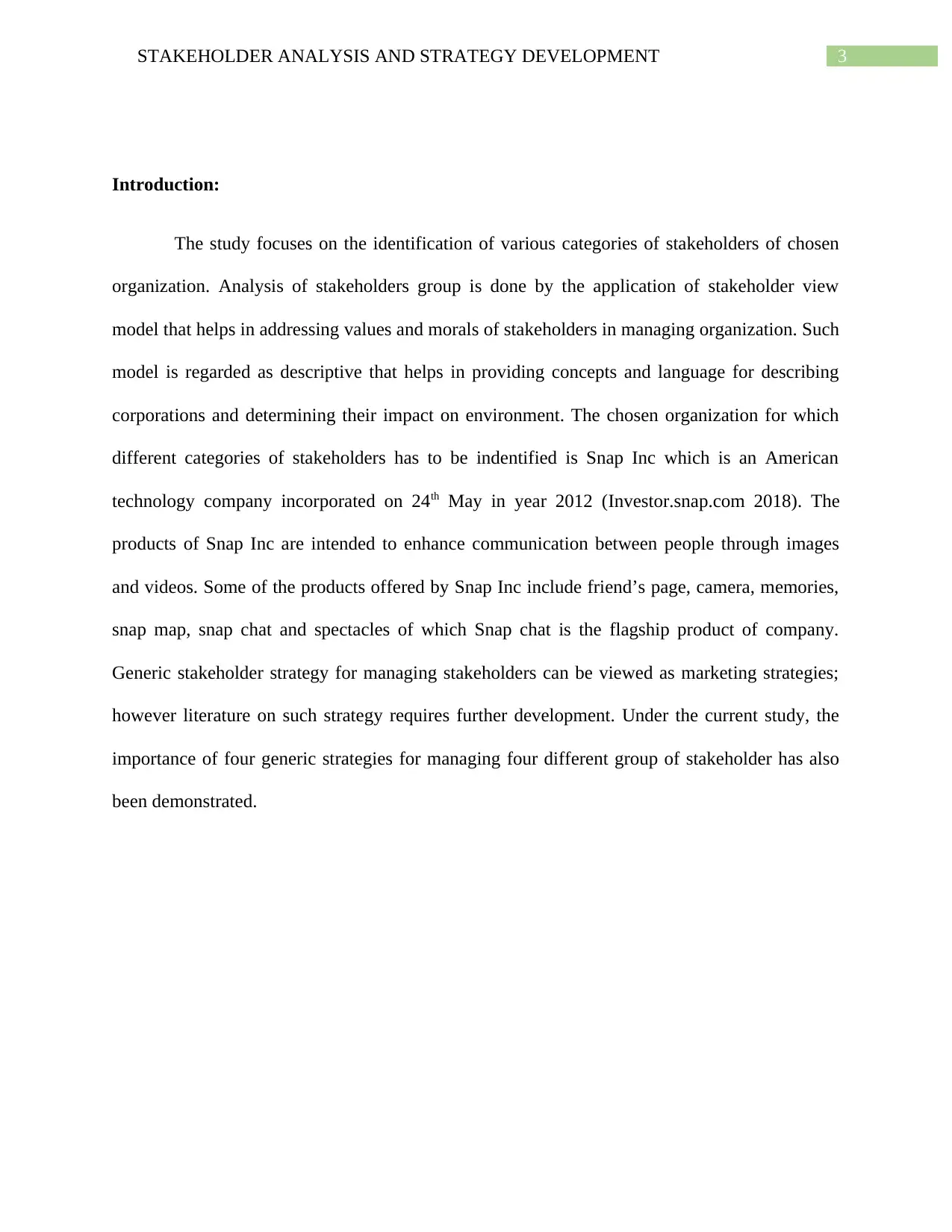
3STAKEHOLDER ANALYSIS AND STRATEGY DEVELOPMENT
Introduction:
The study focuses on the identification of various categories of stakeholders of chosen
organization. Analysis of stakeholders group is done by the application of stakeholder view
model that helps in addressing values and morals of stakeholders in managing organization. Such
model is regarded as descriptive that helps in providing concepts and language for describing
corporations and determining their impact on environment. The chosen organization for which
different categories of stakeholders has to be indentified is Snap Inc which is an American
technology company incorporated on 24th May in year 2012 (Investor.snap.com 2018). The
products of Snap Inc are intended to enhance communication between people through images
and videos. Some of the products offered by Snap Inc include friend’s page, camera, memories,
snap map, snap chat and spectacles of which Snap chat is the flagship product of company.
Generic stakeholder strategy for managing stakeholders can be viewed as marketing strategies;
however literature on such strategy requires further development. Under the current study, the
importance of four generic strategies for managing four different group of stakeholder has also
been demonstrated.
Introduction:
The study focuses on the identification of various categories of stakeholders of chosen
organization. Analysis of stakeholders group is done by the application of stakeholder view
model that helps in addressing values and morals of stakeholders in managing organization. Such
model is regarded as descriptive that helps in providing concepts and language for describing
corporations and determining their impact on environment. The chosen organization for which
different categories of stakeholders has to be indentified is Snap Inc which is an American
technology company incorporated on 24th May in year 2012 (Investor.snap.com 2018). The
products of Snap Inc are intended to enhance communication between people through images
and videos. Some of the products offered by Snap Inc include friend’s page, camera, memories,
snap map, snap chat and spectacles of which Snap chat is the flagship product of company.
Generic stakeholder strategy for managing stakeholders can be viewed as marketing strategies;
however literature on such strategy requires further development. Under the current study, the
importance of four generic strategies for managing four different group of stakeholder has also
been demonstrated.
Paraphrase This Document
Need a fresh take? Get an instant paraphrase of this document with our AI Paraphraser
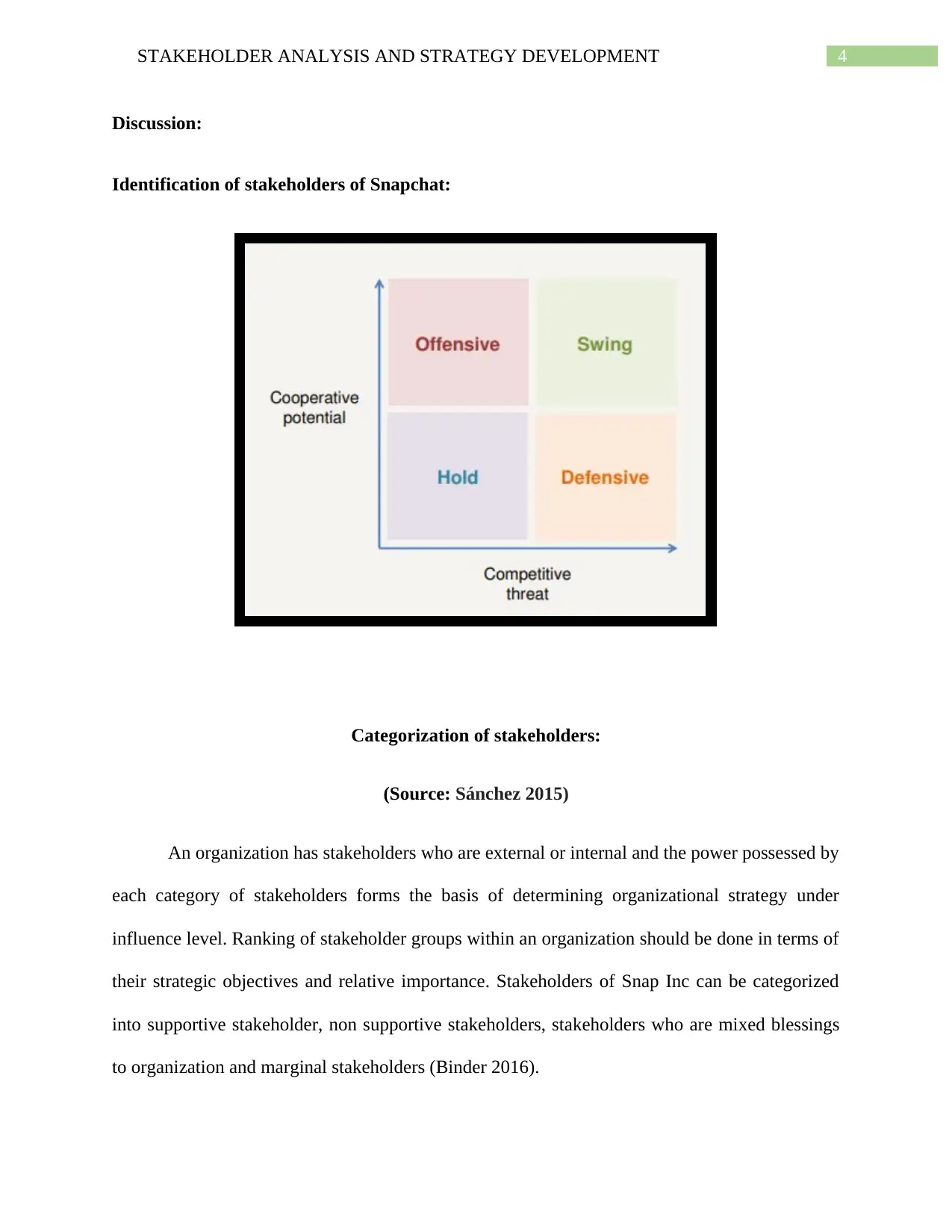
4STAKEHOLDER ANALYSIS AND STRATEGY DEVELOPMENT
Discussion:
Identification of stakeholders of Snapchat:
Categorization of stakeholders:
(Source: Sánchez 2015)
An organization has stakeholders who are external or internal and the power possessed by
each category of stakeholders forms the basis of determining organizational strategy under
influence level. Ranking of stakeholder groups within an organization should be done in terms of
their strategic objectives and relative importance. Stakeholders of Snap Inc can be categorized
into supportive stakeholder, non supportive stakeholders, stakeholders who are mixed blessings
to organization and marginal stakeholders (Binder 2016).
Discussion:
Identification of stakeholders of Snapchat:
Categorization of stakeholders:
(Source: Sánchez 2015)
An organization has stakeholders who are external or internal and the power possessed by
each category of stakeholders forms the basis of determining organizational strategy under
influence level. Ranking of stakeholder groups within an organization should be done in terms of
their strategic objectives and relative importance. Stakeholders of Snap Inc can be categorized
into supportive stakeholder, non supportive stakeholders, stakeholders who are mixed blessings
to organization and marginal stakeholders (Binder 2016).

5STAKEHOLDER ANALYSIS AND STRATEGY DEVELOPMENT
Marginal stakeholders are actually categorized as hold stakeholders who can be of
relatively little harmful or helpful to organization. Such stakeholders do not have much concern
about the issues prevailing in the organization and they have potentially stake in the decision
making of organization. Supportive stakeholders are those stakeholders who are high on
potential for cooperation and low on potential threat. Some of the supportive stakeholders in well
managed organization include staff employees, trustees, managers and parent company
(Pfefferbaum et al. 2016). Such stakeholders contribute to organization greatly in achieving its
objectives with posing a relatively little threat. Non supportive stakeholders can be categorized
as defensive stakeholders having high competitive threat and low cooperative potential.
Organizations can be prevented from achieving its objectives due to the steps taken by such
stakeholders and they can be of little help further. The mixed blessing stakeholders are
categorized as swing stakeholders who are high on both the competitive threat and cooperative
potential. Major role is played by swing stakeholders and stakeholders falling into this particular
category include customers, clients and employees who are in short supply (Bryson 2018). Such
mixed blessing stakeholders can be either less or more supportive to organizations.
Marginal stakeholders are actually categorized as hold stakeholders who can be of
relatively little harmful or helpful to organization. Such stakeholders do not have much concern
about the issues prevailing in the organization and they have potentially stake in the decision
making of organization. Supportive stakeholders are those stakeholders who are high on
potential for cooperation and low on potential threat. Some of the supportive stakeholders in well
managed organization include staff employees, trustees, managers and parent company
(Pfefferbaum et al. 2016). Such stakeholders contribute to organization greatly in achieving its
objectives with posing a relatively little threat. Non supportive stakeholders can be categorized
as defensive stakeholders having high competitive threat and low cooperative potential.
Organizations can be prevented from achieving its objectives due to the steps taken by such
stakeholders and they can be of little help further. The mixed blessing stakeholders are
categorized as swing stakeholders who are high on both the competitive threat and cooperative
potential. Major role is played by swing stakeholders and stakeholders falling into this particular
category include customers, clients and employees who are in short supply (Bryson 2018). Such
mixed blessing stakeholders can be either less or more supportive to organizations.
⊘ This is a preview!⊘
Do you want full access?
Subscribe today to unlock all pages.

Trusted by 1+ million students worldwide

6STAKEHOLDER ANALYSIS AND STRATEGY DEVELOPMENT
Snap Inc
Shareholders/ Investors
Managers
Suppliers Business partners
Government
Trustees
Community/society
CustomersVendors
Owners
Stakeholder group of Snap Inc:
(Source: created by author)
Analysis of stakeholder using stakeholder view model:
It can be seen that the stakeholder view model categorizes stakeholders into four
categories such as supportive stakeholders, non supportive stakeholders, and marginal
stakeholders and mixed blessing stakeholders.
Customers- Customers can be regarded as stakeholder falling into the category of mixed
stakeholders. Customers do not generally require or obtain collateral and under the contractual
arrangement, they are provided with the facility of extending credit by evaluating their ability to
make payments. Recognition of revenue from advertising products is done when there exists
Snap Inc
Shareholders/ Investors
Managers
Suppliers Business partners
Government
Trustees
Community/society
CustomersVendors
Owners
Stakeholder group of Snap Inc:
(Source: created by author)
Analysis of stakeholder using stakeholder view model:
It can be seen that the stakeholder view model categorizes stakeholders into four
categories such as supportive stakeholders, non supportive stakeholders, and marginal
stakeholders and mixed blessing stakeholders.
Customers- Customers can be regarded as stakeholder falling into the category of mixed
stakeholders. Customers do not generally require or obtain collateral and under the contractual
arrangement, they are provided with the facility of extending credit by evaluating their ability to
make payments. Recognition of revenue from advertising products is done when there exists
Paraphrase This Document
Need a fresh take? Get an instant paraphrase of this document with our AI Paraphraser

7STAKEHOLDER ANALYSIS AND STRATEGY DEVELOPMENT
persuasive evidence of arrangements. For returning of the products, customers are provided with
the limited rights. In addition to this, customer creditworthiness is judged based on historical
experience and ongoing evaluation of their credits that helps in determining the amount of
allowance. Snap Inc has norms of recognizing revenue from customers which promises
transferring of goods and services in an amount reflecting consideration which entitles the entity
in exchange for goods and services. Advertising customers were integrated with advertising tools
and existing platform for advertising by acquisition of business component (Higgins and Coffey
2016).
Stockholders/Shareholders- Litigation concerning stakeholder’s subjects Snap Inc to
divert resources and substantial cost and management attention from the business. Business of
Snap Inc could be harmed seriously if such claims are successful. Any announcements to
shareholders or investors about financial information and material business are done by using
website of investor relation. There can be wide variations and idiosyncratic in the expectation
and future perceptions of investors. Furthermore, investors demand forms the basis of the ability
of Snap Inc to obtain additional amount of finance. The overall understanding of investors
regarding the financial performance can be enhanced by the application of non GAAP financial
measures (Herrera 2015).
Managers- The chief operating decision maker of organization is CEO of Snap Inc who
is responsible for reviewing financial information that is presented on the basis of consolidation
accompanies by the information about revenue that is disaggregated by geographic union. The
chief operating decision maker do not held segment manager accountable for operating results,
operations and planning for level or components below the level of consolidated unit (Bolisani
persuasive evidence of arrangements. For returning of the products, customers are provided with
the limited rights. In addition to this, customer creditworthiness is judged based on historical
experience and ongoing evaluation of their credits that helps in determining the amount of
allowance. Snap Inc has norms of recognizing revenue from customers which promises
transferring of goods and services in an amount reflecting consideration which entitles the entity
in exchange for goods and services. Advertising customers were integrated with advertising tools
and existing platform for advertising by acquisition of business component (Higgins and Coffey
2016).
Stockholders/Shareholders- Litigation concerning stakeholder’s subjects Snap Inc to
divert resources and substantial cost and management attention from the business. Business of
Snap Inc could be harmed seriously if such claims are successful. Any announcements to
shareholders or investors about financial information and material business are done by using
website of investor relation. There can be wide variations and idiosyncratic in the expectation
and future perceptions of investors. Furthermore, investors demand forms the basis of the ability
of Snap Inc to obtain additional amount of finance. The overall understanding of investors
regarding the financial performance can be enhanced by the application of non GAAP financial
measures (Herrera 2015).
Managers- The chief operating decision maker of organization is CEO of Snap Inc who
is responsible for reviewing financial information that is presented on the basis of consolidation
accompanies by the information about revenue that is disaggregated by geographic union. The
chief operating decision maker do not held segment manager accountable for operating results,
operations and planning for level or components below the level of consolidated unit (Bolisani
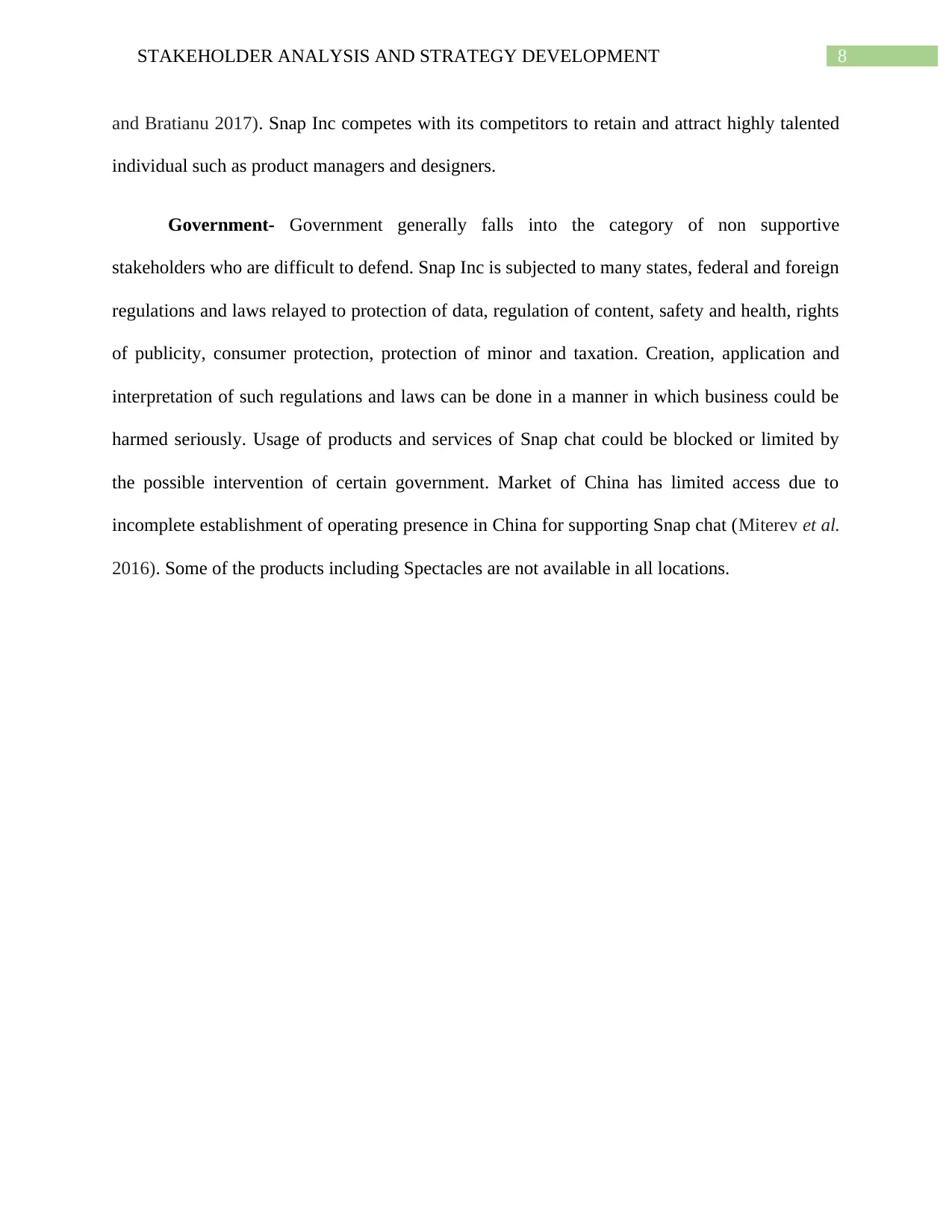
8STAKEHOLDER ANALYSIS AND STRATEGY DEVELOPMENT
and Bratianu 2017). Snap Inc competes with its competitors to retain and attract highly talented
individual such as product managers and designers.
Government- Government generally falls into the category of non supportive
stakeholders who are difficult to defend. Snap Inc is subjected to many states, federal and foreign
regulations and laws relayed to protection of data, regulation of content, safety and health, rights
of publicity, consumer protection, protection of minor and taxation. Creation, application and
interpretation of such regulations and laws can be done in a manner in which business could be
harmed seriously. Usage of products and services of Snap chat could be blocked or limited by
the possible intervention of certain government. Market of China has limited access due to
incomplete establishment of operating presence in China for supporting Snap chat (Miterev et al.
2016). Some of the products including Spectacles are not available in all locations.
and Bratianu 2017). Snap Inc competes with its competitors to retain and attract highly talented
individual such as product managers and designers.
Government- Government generally falls into the category of non supportive
stakeholders who are difficult to defend. Snap Inc is subjected to many states, federal and foreign
regulations and laws relayed to protection of data, regulation of content, safety and health, rights
of publicity, consumer protection, protection of minor and taxation. Creation, application and
interpretation of such regulations and laws can be done in a manner in which business could be
harmed seriously. Usage of products and services of Snap chat could be blocked or limited by
the possible intervention of certain government. Market of China has limited access due to
incomplete establishment of operating presence in China for supporting Snap chat (Miterev et al.
2016). Some of the products including Spectacles are not available in all locations.
⊘ This is a preview!⊘
Do you want full access?
Subscribe today to unlock all pages.

Trusted by 1+ million students worldwide
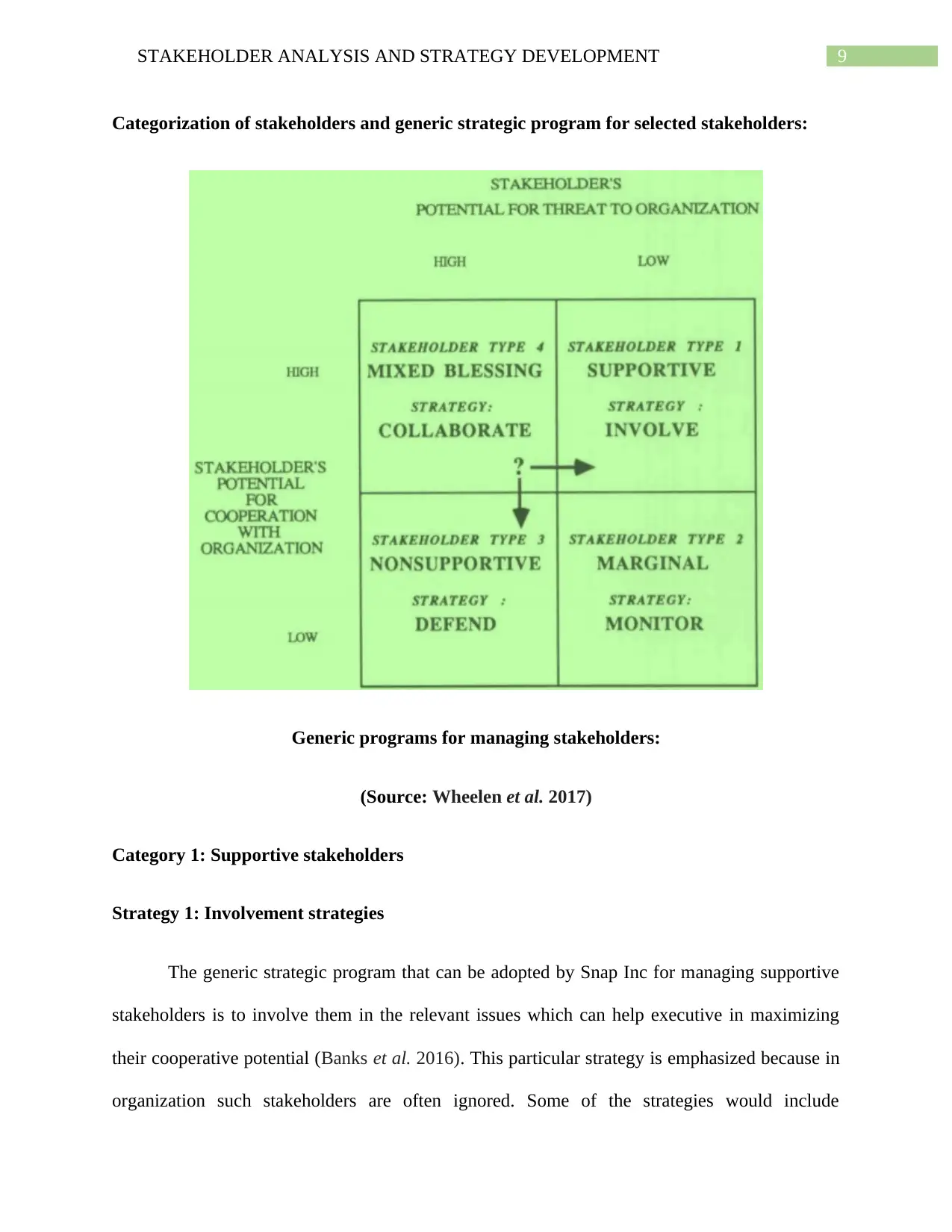
9STAKEHOLDER ANALYSIS AND STRATEGY DEVELOPMENT
Categorization of stakeholders and generic strategic program for selected stakeholders:
Generic programs for managing stakeholders:
(Source: Wheelen et al. 2017)
Category 1: Supportive stakeholders
Strategy 1: Involvement strategies
The generic strategic program that can be adopted by Snap Inc for managing supportive
stakeholders is to involve them in the relevant issues which can help executive in maximizing
their cooperative potential (Banks et al. 2016). This particular strategy is emphasized because in
organization such stakeholders are often ignored. Some of the strategies would include
Categorization of stakeholders and generic strategic program for selected stakeholders:
Generic programs for managing stakeholders:
(Source: Wheelen et al. 2017)
Category 1: Supportive stakeholders
Strategy 1: Involvement strategies
The generic strategic program that can be adopted by Snap Inc for managing supportive
stakeholders is to involve them in the relevant issues which can help executive in maximizing
their cooperative potential (Banks et al. 2016). This particular strategy is emphasized because in
organization such stakeholders are often ignored. Some of the strategies would include
Paraphrase This Document
Need a fresh take? Get an instant paraphrase of this document with our AI Paraphraser

10STAKEHOLDER ANALYSIS AND STRATEGY DEVELOPMENT
decentralization of authority and implementing the techniques for increasing participative
management.
Category 2: Non supportive stakeholders
Strategy 2: Defensive strategies
Implementing defensive strategy is a best way to manage the no supportive group of
stakeholders. There would be reduced dependence of the facts forming the basis of interest of
stakeholders in terms of external dependence on framework of Kotler. There is a clear
connection of stakeholder management to a broader degree of strategic management using
defensive strategy. However, such strategic need might be required in initial stage; the status of
key stakeholders should be changed by finding out right ways by executives.
Category 3: Mixed blessing stakeholders
Strategy 3: Swing strategy
When a group is mixed blessings to organization, strategy of swing should be adopted.
Under such strategy, it is required by firm to take decision such as transaction process, decision
forum and influencing the rules governing the interaction with stakeholders. Collaboration
strategy can better help in managing such stakeholders as they it would become more difficult
for them to oppose the organization (Maas et al. 2016). There are varieties of collaborative
efforts including mergers and acquisition that can be implemented by the organization.
Category 4: Marginal stakeholders
Strategy 4: Hold strategy
decentralization of authority and implementing the techniques for increasing participative
management.
Category 2: Non supportive stakeholders
Strategy 2: Defensive strategies
Implementing defensive strategy is a best way to manage the no supportive group of
stakeholders. There would be reduced dependence of the facts forming the basis of interest of
stakeholders in terms of external dependence on framework of Kotler. There is a clear
connection of stakeholder management to a broader degree of strategic management using
defensive strategy. However, such strategic need might be required in initial stage; the status of
key stakeholders should be changed by finding out right ways by executives.
Category 3: Mixed blessing stakeholders
Strategy 3: Swing strategy
When a group is mixed blessings to organization, strategy of swing should be adopted.
Under such strategy, it is required by firm to take decision such as transaction process, decision
forum and influencing the rules governing the interaction with stakeholders. Collaboration
strategy can better help in managing such stakeholders as they it would become more difficult
for them to oppose the organization (Maas et al. 2016). There are varieties of collaborative
efforts including mergers and acquisition that can be implemented by the organization.
Category 4: Marginal stakeholders
Strategy 4: Hold strategy
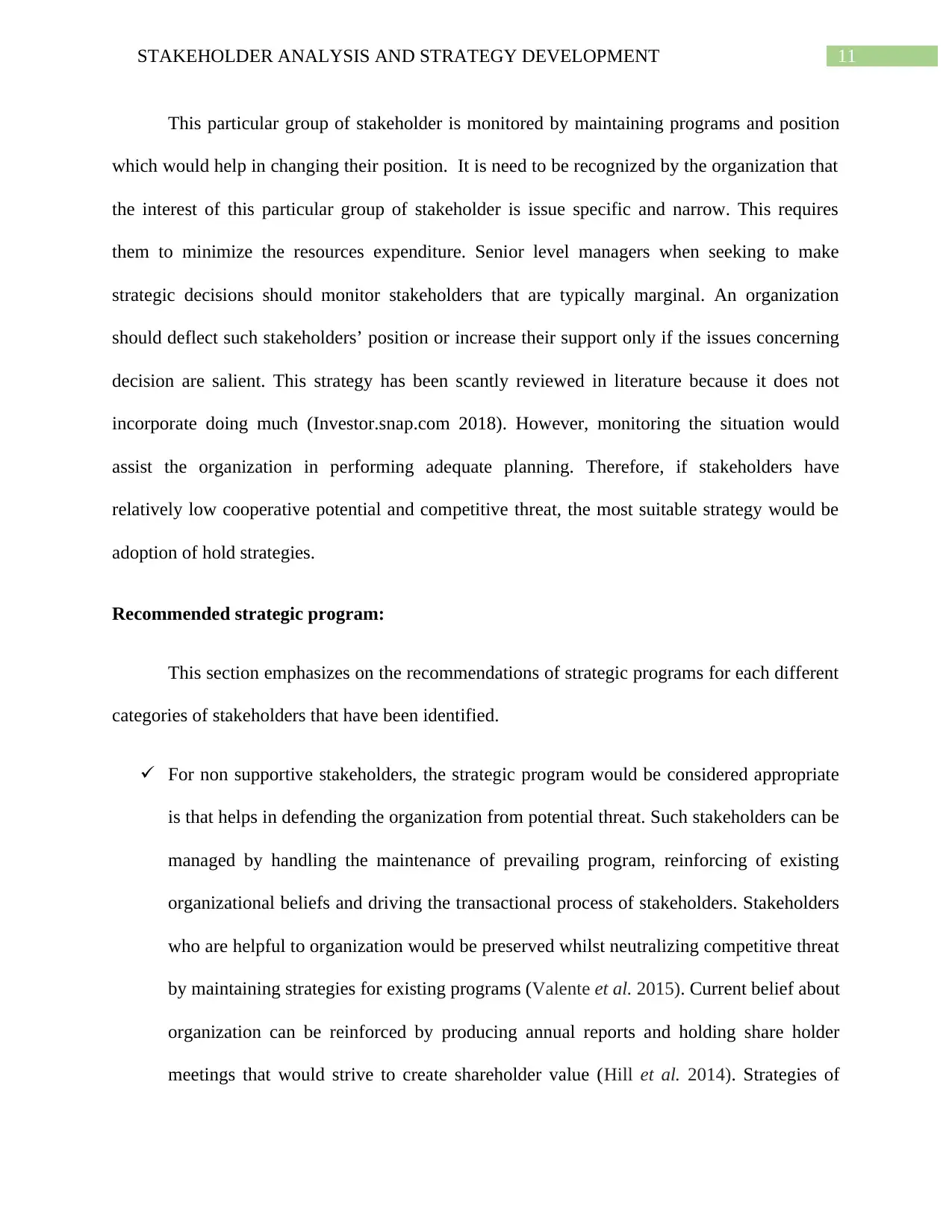
11STAKEHOLDER ANALYSIS AND STRATEGY DEVELOPMENT
This particular group of stakeholder is monitored by maintaining programs and position
which would help in changing their position. It is need to be recognized by the organization that
the interest of this particular group of stakeholder is issue specific and narrow. This requires
them to minimize the resources expenditure. Senior level managers when seeking to make
strategic decisions should monitor stakeholders that are typically marginal. An organization
should deflect such stakeholders’ position or increase their support only if the issues concerning
decision are salient. This strategy has been scantly reviewed in literature because it does not
incorporate doing much (Investor.snap.com 2018). However, monitoring the situation would
assist the organization in performing adequate planning. Therefore, if stakeholders have
relatively low cooperative potential and competitive threat, the most suitable strategy would be
adoption of hold strategies.
Recommended strategic program:
This section emphasizes on the recommendations of strategic programs for each different
categories of stakeholders that have been identified.
For non supportive stakeholders, the strategic program would be considered appropriate
is that helps in defending the organization from potential threat. Such stakeholders can be
managed by handling the maintenance of prevailing program, reinforcing of existing
organizational beliefs and driving the transactional process of stakeholders. Stakeholders
who are helpful to organization would be preserved whilst neutralizing competitive threat
by maintaining strategies for existing programs (Valente et al. 2015). Current belief about
organization can be reinforced by producing annual reports and holding share holder
meetings that would strive to create shareholder value (Hill et al. 2014). Strategies of
This particular group of stakeholder is monitored by maintaining programs and position
which would help in changing their position. It is need to be recognized by the organization that
the interest of this particular group of stakeholder is issue specific and narrow. This requires
them to minimize the resources expenditure. Senior level managers when seeking to make
strategic decisions should monitor stakeholders that are typically marginal. An organization
should deflect such stakeholders’ position or increase their support only if the issues concerning
decision are salient. This strategy has been scantly reviewed in literature because it does not
incorporate doing much (Investor.snap.com 2018). However, monitoring the situation would
assist the organization in performing adequate planning. Therefore, if stakeholders have
relatively low cooperative potential and competitive threat, the most suitable strategy would be
adoption of hold strategies.
Recommended strategic program:
This section emphasizes on the recommendations of strategic programs for each different
categories of stakeholders that have been identified.
For non supportive stakeholders, the strategic program would be considered appropriate
is that helps in defending the organization from potential threat. Such stakeholders can be
managed by handling the maintenance of prevailing program, reinforcing of existing
organizational beliefs and driving the transactional process of stakeholders. Stakeholders
who are helpful to organization would be preserved whilst neutralizing competitive threat
by maintaining strategies for existing programs (Valente et al. 2015). Current belief about
organization can be reinforced by producing annual reports and holding share holder
meetings that would strive to create shareholder value (Hill et al. 2014). Strategies of
⊘ This is a preview!⊘
Do you want full access?
Subscribe today to unlock all pages.

Trusted by 1+ million students worldwide
1 out of 17
Related Documents
Your All-in-One AI-Powered Toolkit for Academic Success.
+13062052269
info@desklib.com
Available 24*7 on WhatsApp / Email
![[object Object]](/_next/static/media/star-bottom.7253800d.svg)
Unlock your academic potential
Copyright © 2020–2025 A2Z Services. All Rights Reserved. Developed and managed by ZUCOL.





